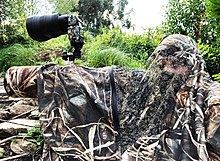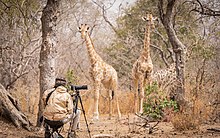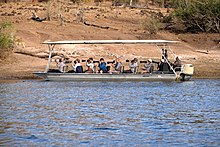Different Kinds of Pictures of Animals

Wildlife photographer under the portable hide

Wildlife photographer observing giraffes in Sumu Wildlife Park in Bauchi state, Nigeria

Wildlife photography is a genre of photography concerned with documenting various forms of wildlife in their natural habitat.
As well as requiring photography skills, wildlife photographers may need field craft skills. For example, some animals and birds are difficult to approach and thus a knowledge of the animal's and birds behavior is needed in order to be able to predict its actions. Photographing some species may require stalking skills or the use of a hide/blind for concealment.
While wildlife photographs can be taken using basic equipment, successful photography of some types of wildlife requires specialist equipment, such as macro lenses for insects, long focal length lenses for birds and underwater cameras for marine life. However, a great wildlife photograph can also be the result of being in the right place at the right time[1] and often involves a good understanding of animal behavior in order to anticipate interesting situations to capture in photography.
History [edit]

In the early days of photography, it was difficult to get a photograph of wildlife due to slow lenses and the low sensitivity of photographic media.[3] Earlier photos of animals were usually pets, stuffed,[4] and zoo animals.[5] [6] These included photos of lion cubs taken at the Bristol zoo in 1854 and in 1864, photos of the last Quagga by Frank Hayes.[7] Wildlife photography gained more traction when faster photography emulsions and quicker shutters came in the 1880s.[8] Developments like these lead to photos such as the ones taken by German Ottomar Anschutz in 1884, the first shots of wild birds in action.[8] In July 1906, National Geographic published its first wildlife photos.[9] The photos were taken by George Shiras III, a U.S. Representative from Pennsylvania. Some of his photos were taken with the first wire-tripped camera traps.[10] [11]
Definition [edit]
The world's three largest photography organisations, the Photographic Society of America, the Fédération Internationale de l'Art Photographique and the Royal Photographic Society have adopted a common definition for nature and wildlife photography to govern photography competitions, their respective presidents writing in a joint statement, "The development of a common definition for nature and wildlife photography will be an important step in helping photographers, many of whom enter competitions internationally, know what the rules are. It will also provide organisers with a very clear definition when they need to deal with the problem of ineligible images."[12]
Equipment [edit]
Equipment for wildlife photography can be very specialized and often uses different lenses and equipment than most other disciplines. Most wildlife lenses have a very long focal length between 150mm and 600mm, allowing the photographer to get a tighter image filling the frame with their chosen subject. However, whilst the majority of wildlife is shot with a telephoto lens, when a wide-angle lens is used, it can provide striking shots of animals within their environment.[13]
Some other specialized gear includes camera traps, hides, ghillie suits and flash extenders. Wildlife photographers have also used special Human Energy Concealment Systems (known as HECS) to reduce disruption to wildlife while photographing.[14]
Photography tips for insects [edit]
Macrophotography techniques are common for taking pictures of insects. Some specific techniques can be of particular value, for example, you should shoot in good light, avoid the photographer's shadow onto the subject, choose places where insects are not a few, but rather plenty.[15] It's a good idea to use a digital camera to take burst shots and then select your best shots, or to use a flash or telephoto lens. Small depth of field in macro photography can often necessitate an additional aperture, sometimes sacrificing some of the image quality by setting a higher light sensitivity.[16]
Photography tips for birds [edit]
Many birds are well-sighted, have a good memory, and can distinguish a large number of color shades.[17] [18] This is why a photographer would be wise to use natural means of camouflage, prepare a shelter in advance or accustom the birds to their presence. Alternatively, use a decoy or motion-sensor camera to take photos of birds.[19]
Most bird photography utilizes telephoto lenses. Long lenses are more susceptible to camera shake.[20]
Photography tips for animals [edit]
Camouflage is an important element of wildlife photography. A photographer should have his/her appearance transformed and his/her equipment camouflaged with special covers and camouflage netting. Special overlays are available to muffle the sound of the camera's shutter release mechanism. The hissing sound the electronic flash capacitors typically make is likewise unnatural and can be heard from a far distance.
Animals are good at smelling. Avoiding the use of any deodorants, toilet water, or perfume is strongly recommended. It is also important to keep the wind direction in mind, as animals are good at recognizing human scent. A general recommendation when taking photos of animals is to wait silently and motionless in a shelter positioned to the leeward side.
Ethics [edit]
A photographer is first and foremost a witness to wildlife. Show respect for your models and do not interfere with the animal's behavior. Don't take a shot that will put your model in undue distress.[21] [22]
Sometimes photographers use live bait to get a picture. The photos taken this way are rejected in major photo contests, as this practice is unethical.[23]
See also [edit]
- BeetleCam
- Digiscoping
- Escape distance of animals
- High-speed photography
- National Wildlife Magazine
- Nature photographers
- Nature photography
- Project Noah
- Wildlife observation
References [edit]
- ^ "animal picture society". Retrieved 7 February 2016.
- ^ Eric Hosking; Harold Lowes (1947), Masterpieces of Bird Photography, William Collins, Sons, p. 9, ASIN B000O8CPQK, Wikidata Q108533626
- ^ "Answers - the Most Trusted Place for Answering Life's Questions".
- ^ Brower, Matthew (2011). Developing Animals: Wildlife and Early American Photography. ISBN9780816654789.
- ^ http://www.markcarwardine.com/uploads/articles/bbc_wildlife/history_wildlife_photography.pdf
- ^ "A Brief History of Animals in Photography". 2015-06-04.
- ^ Cox, Rosamund Kidman, ed. (2014). Wildlife Photographer of the Year. Firefly Books. p. 13.
- ^ a b Cox, Rosamund Kidman, ed. (2014). Wildlife Photographer of the Year. Firefly Books.
- ^ http://photography.nationalgeographic.com/photography/photographers/first-wildlife-photos.html
- ^ http://photography.nationalgeographic.com/photography/photographers/digital-camera-trap-article.html
- ^ "These Were the First Wildlife Photographs Published in National Geographic".
- ^ http://rps.org/news/2014/may/nature-definition-agreed Accessed 25 May 2014
- ^ Hamblin, Mark (2016-08-28). "How to Photograph Animals in Their Habitat". Nature TTL . Retrieved 2019-08-06 .
- ^ "Photographing Wildlife". HECS® Wildlife . Retrieved 2021-01-27 .
- ^ "Macro Photography Lighting for Beginners". Photography-RAW. 6 June 2019. Retrieved 28 December 2020.
- ^ "The Macro Photography Rule Book: Think Differently". Fstoppers. 6 July 2019. Retrieved 28 December 2020.
- ^ "Wild Birds Remember a Novel Task for Nearly Two Years". The Scientist . Retrieved 28 December 2020.
- ^ "How Birds See Color". The Spruce . Retrieved 28 December 2020.
- ^ "Hunting by ear". Natural History Museum . Retrieved 28 December 2020.
- ^ "Shooting Wildlife (With a Camera)". National Geographic. 7 March 2012. Retrieved 28 December 2020.
- ^ "Principle 6: Respect Wildlife". Leave No Trace Center for Outdoor Ethics . Retrieved 28 December 2020.
- ^ "Is It Ever Morally Wrong To Take Pictures Of Animals? One Wildlife Photographer Says Yes". WBUR . Retrieved 28 December 2020.
- ^ "Winning at What Cost? Ethical Considerations for Wildlife and Nature Photo Contests". The International League of Conservation Photographers . Retrieved 28 December 2020.
Different Kinds of Pictures of Animals
Source: https://en.wikipedia.org/wiki/Wildlife_photography
0 Response to "Different Kinds of Pictures of Animals"
Post a Comment